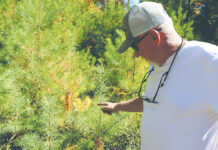A study released by the Ohio Department of Natural Resources found that oil and gas production waste from an injection well in Washington County did not impact drinking water in the area.
Brine from the Redbird #4 injection well in Dunham Township migrated out of its injection zone in 2019 and into several nearby oil and gas production wells, according to an earlier ODNR report. That brine did not affect the private drinking water wells tested, according to results from a follow-up report that was published earlier this summer.
The ODNR’s Division of Oil and Gas commissioned an independent investigation to verify the brine had not migrated from the Berea Sandstone into shallower drinking water aquifers. The report, put together by Groundwater and Environmental Services, noted that no residents complained about water quality issues in the area.
GES identified 596 parcels and 48 private water wells within a half mile radius of the impacted wells. Of those, 16 were reported as no longer present by landowners, four landowners declined sampling and landowners for 24 wells did not respond to requests for contact and sampling by GES.
A total of nine wells were sampled and analyzed, including five that were not identified in the original survey.
One sample had a chloride concentration above the EPA maximum level of 250 milligrams per liter along with measurable bromide. The report notes that “chloride does occur naturally in groundwater and concentrations can vary depending on the soil and/or bedrock matrix the groundwater moves through.”
This sample came from a 60-foot deep well about 8,100 feet northeast of the injection well. Chloride can also come from a number of other sources, including sewage effluent, irrigation drainage, animal manure and fertilizer, the report said. GES concluded the elevated chloride in the sample was not caused by the brine from the Redbird #4 well.
Back story
The issue with the injection well was first noticed in late 2019 when three well operators reported a higher than normal amount of brine in 28 Berea Sandstone oil and gas production wells. Those operators believed the brine came from the nearby class II saltwater injection well, Redbird #4.
A report put together by Resource Services International, released last fall, confirmed brine had migrated from the Ohio Shale formation where it was injected into the Berea Sandstone formation through naturally occurring fissures.
Redbird #4 has not been injected since November 2019 due to an unrelated problem. As of May 2020, the owner voluntarily completed modifications to the well to seal off the Ohio Shale formation. ODNR stated it was unlikely the brine would migrate farther than it already had.










